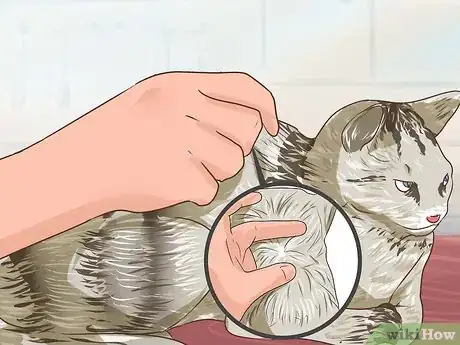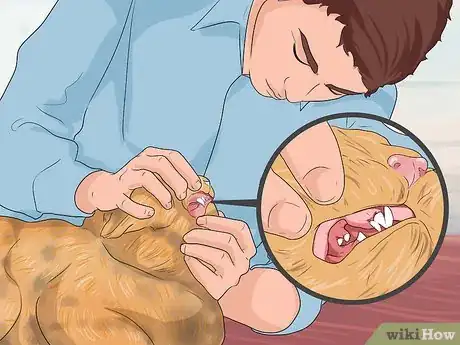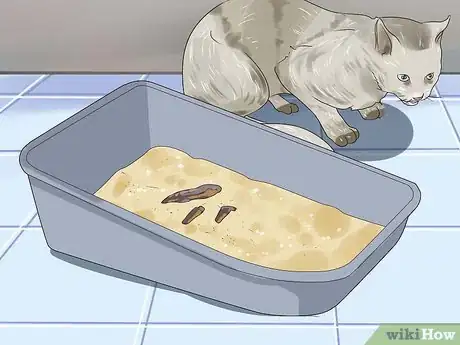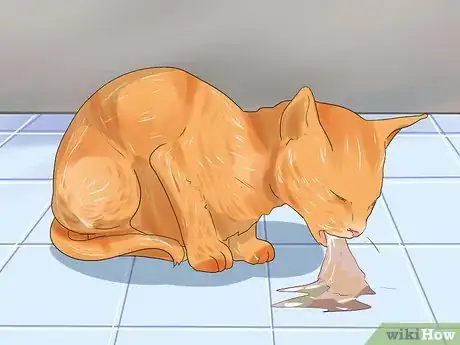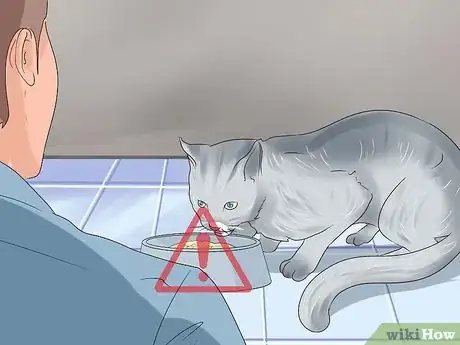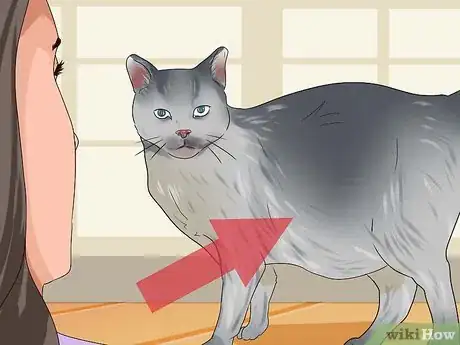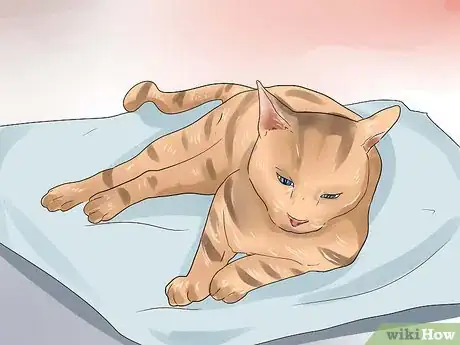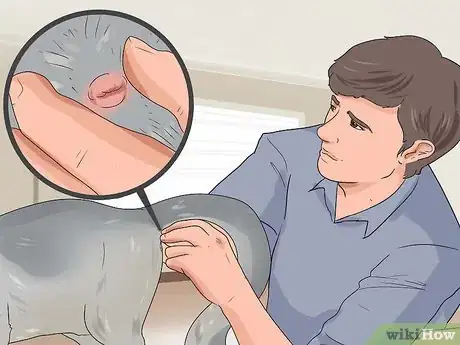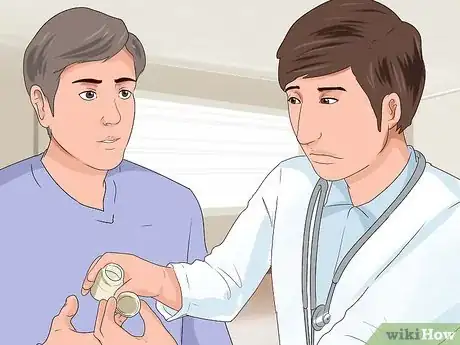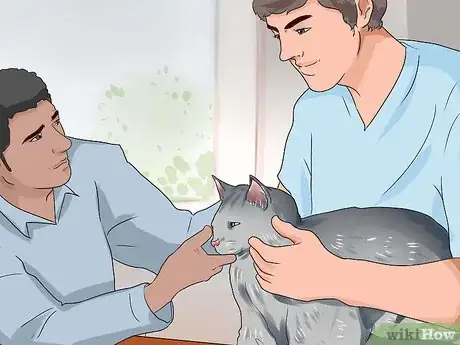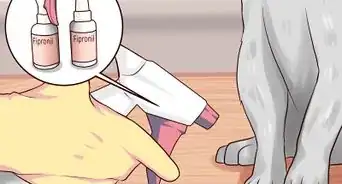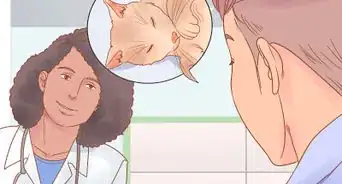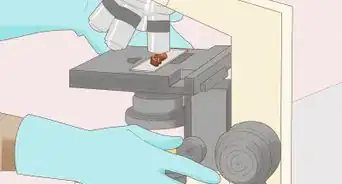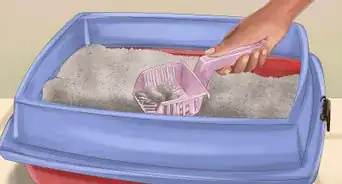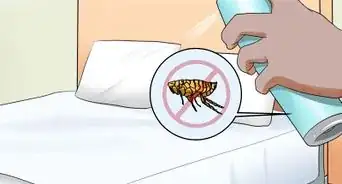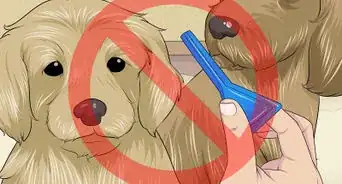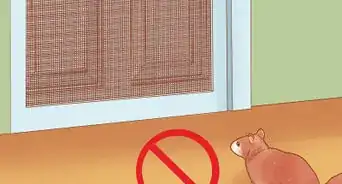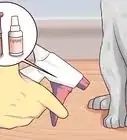This article was co-authored by Pippa Elliott, MRCVS. Dr. Elliott, BVMS, MRCVS is a veterinarian with over 30 years of experience in veterinary surgery and companion animal practice. She graduated from the University of Glasgow in 1987 with a degree in veterinary medicine and surgery. She has worked at the same animal clinic in her hometown for over 20 years.
wikiHow marks an article as reader-approved once it receives enough positive feedback. This article received 43 testimonials and 94% of readers who voted found it helpful, earning it our reader-approved status.
This article has been viewed 1,347,047 times.
Whether they live exclusively indoors or spend time outside, pet cats may become host to internal parasites such as roundworms, tapeworms, and hookworms.[1] Kittens often pick up worms from the mother in her milk, while adult cats pick up worms by accidentally eating worm eggs or eating vermin infested with worms. Because it is relatively easy for a cat to acquire worms, it is a good idea to know the warning signs so you can seek veterinary treatment for the problem early on.[2] Untreated, worms can cause symptoms such as a dull coat or a potbelly, but it is rare they make a cat seriously unwell. Getting rid of worms is relatively easy with the correct worming medication,[3] and with a little knowledge, it's also easy to determine if your cat might have worms.
Steps
Checking for Symptoms
-
1
-
2Check your cat's gums. A healthy cat has pink gums, much like our own. If your cat's gums are pale or white, this could be a sign that it is anemic. A common explanation for this can be a parasite infection.[6]
- To check your cat's gums, sit him or her in your lap or next to you, gently grasp the cat's head in your hands, under the jaw and behind the ears. Use your fingertips to lift the flap of the cat's upper lip so that the gums above the teeth are exposed.[7]
- If the gums are pale, you should contact your vet as soon as possible.
Advertisement -
3Examine your cat's feces. If your cat uses a litter box, it is easy to keep an eye on its feces. Watch for the following symptoms:
- Dark, tarry stools may indicate blood loss from where hookworms attached themselves to the wall of the intestine.[8]
- Diarrhea can occur because worms also take up space within the gut and interfere with digestion.[9]
- If your cat has diarrhea for more than 24 hours, or if you see fresh blood or dark tarry stools, seek veterinary help.
-
4
-
5
-
6Look for changes in the shape of your cat's body. Cats with a lot of worms may develop a potbelly, causing the abdominal area to look swollen.[14]
- Like vomiting, this is a general symptom and can happen for a variety of reasons, but this sign is sufficient to warrant a trip to the vet, whatever the underlying cause.[15]
-
7Notice signs of lethargy. If the worms are stealing nutrition direct from the bowel, the cat or kitten will feel lethargic, appear listless, and lack energy.[16] Pay attention to any dramatic changes in your cat's energy level.
- Again, this can be a symptom of many different ailments, and is one that warrants a vet check up.[17]
- You know your cat's normal energy level best, so keep your eye out for any sudden reduction in energy or playfulness.
Looking for Evidence
-
1Check for eggs in the cat's feces. Put on some disposable plastic gloves and use a disposable tool such as a popsicle stick to examine feces in the litter box for signs of parasites.
- Tapeworms may leave egg packets stuck to the surface of the stool. These look like sesame or cucumber seeds, and sometimes wriggle and move.[18]
- It is unusual to see a whole tapeworm in cat feces, but they look like flat, cream-colored worms made up of many segments. An adult tapeworm can reach about two feet (60 centimeters) in length.[19]
- Roundworm eggs are too small to see with the naked eye, but sometimes whole worms do pass out in the feces, or may even be vomited up. Roundworms look like spaghetti: long and smooth and about the same diameter as a strand of pasta. An adult roundworm is usually just three to six inches long.[20]
- Hookworm eggs are also too small to see. An adult hookworm is likewise tiny, measuring a mere two to three millimeters long, and therefore also difficult to detect.[21]
-
2Check your cat's anus. Tapeworm eggs packets migrate out of the cat's anus and stick to the fur. Thus, you can safely conclude your cat has tapeworms if you see creamy-white egg packets, which look like sesame seeds, clinging to the cat's fur.[22]
-
3Examine your cat's bedding and other favorite spots. Egg packets sometimes get stuck on places where the cat has sat, such as bedding or soft furniture, so check these areas if you suspect your cat may have worms.
Testing Your Cat
-
1Call your veterinarian to schedule an exam. If you are concerned your cat may have worms, one of the most reliable ways to find out is to submit a fecal sample for analysis to your local veterinary clinic. The sample will be looked at under a microscope to detect worm eggs.
- Each worm type has different shaped eggs and so this is the most effective way to determine what type (or types) of worms your cat may have.[23]
- When you call the vet, describe any symptoms your cat may be displaying.
-
2Collect a stool sample. If you are asked to collect a sample, you'll need to gather up some of your cat's feces and store the collection container until your appointment.
- Worm eggs are hearty, but for best results, keep the container in a cool, dark place such as a garage or shady shed.[24]
- Do not keep the container in a room where food is prepared, and always wash your hands after collecting a fecal sample.[25]
- To decrease the chances of a false negative on the fecal test, some vets will ask for a pooled sample, which means collecting three bowel movements from three separate days in the same container.[26]
-
3Bring your cat in for an exam. The veterinarian will examine your cat and perform fecal tests if they think it necessary.
- If your cat does have worms, the veterinarian will prescribe medication. Administer as directed and the problem should clear up quickly.
Expert Q&A
-
QuestionWhen can you deworm a cat?
 Pippa Elliott, MRCVSDr. Elliott, BVMS, MRCVS is a veterinarian with over 30 years of experience in veterinary surgery and companion animal practice. She graduated from the University of Glasgow in 1987 with a degree in veterinary medicine and surgery. She has worked at the same animal clinic in her hometown for over 20 years.
Pippa Elliott, MRCVSDr. Elliott, BVMS, MRCVS is a veterinarian with over 30 years of experience in veterinary surgery and companion animal practice. She graduated from the University of Glasgow in 1987 with a degree in veterinary medicine and surgery. She has worked at the same animal clinic in her hometown for over 20 years.
Veterinarian Routine deworming should be done every 3-4 months, more often if they are hunters. Take care when deworming kittens that they are old enough to take the product. The package insert should guide you on the age at which it is safe for kittens to take the medication.
Routine deworming should be done every 3-4 months, more often if they are hunters. Take care when deworming kittens that they are old enough to take the product. The package insert should guide you on the age at which it is safe for kittens to take the medication. -
QuestionWhat are signs that your cat has worms?
 Pippa Elliott, MRCVSDr. Elliott, BVMS, MRCVS is a veterinarian with over 30 years of experience in veterinary surgery and companion animal practice. She graduated from the University of Glasgow in 1987 with a degree in veterinary medicine and surgery. She has worked at the same animal clinic in her hometown for over 20 years.
Pippa Elliott, MRCVSDr. Elliott, BVMS, MRCVS is a veterinarian with over 30 years of experience in veterinary surgery and companion animal practice. She graduated from the University of Glasgow in 1987 with a degree in veterinary medicine and surgery. She has worked at the same animal clinic in her hometown for over 20 years.
Veterinarian The signs are quite vague and include a dull coat, pot belly, thin body condition, diarrhea, and vomiting. Not all cats have all these signs, so if in doubt, it's best to worm the cat.
The signs are quite vague and include a dull coat, pot belly, thin body condition, diarrhea, and vomiting. Not all cats have all these signs, so if in doubt, it's best to worm the cat. -
QuestionCan a cat with worms pass it to humans?
 Pippa Elliott, MRCVSDr. Elliott, BVMS, MRCVS is a veterinarian with over 30 years of experience in veterinary surgery and companion animal practice. She graduated from the University of Glasgow in 1987 with a degree in veterinary medicine and surgery. She has worked at the same animal clinic in her hometown for over 20 years.
Pippa Elliott, MRCVSDr. Elliott, BVMS, MRCVS is a veterinarian with over 30 years of experience in veterinary surgery and companion animal practice. She graduated from the University of Glasgow in 1987 with a degree in veterinary medicine and surgery. She has worked at the same animal clinic in her hometown for over 20 years.
Veterinarian Both cat and dog roundworms can potentially be passed to people, but the risk is low. Tapeworms cannot be passed directly but require an intermediate host, and are therefore unlikely to infect people.
Both cat and dog roundworms can potentially be passed to people, but the risk is low. Tapeworms cannot be passed directly but require an intermediate host, and are therefore unlikely to infect people.
Warnings
- If you suspect worms or have checked your cat for worms, wash your hands after handling your cat, remove all excrement from litter boxes immediately, and keep small children away from the cat until you can get to the veterinarian for treatment.⧼thumbs_response⧽
- Be aware the sometimes negative fecal tests are misleading. Some parasites shed eggs inconsistently, so even when a cat has an infection, there may not be any evidence in the stool sample you've collected. Repeated testing may be required to diagnose some parasite infections.[30]⧼thumbs_response⧽
References
- ↑ Parasites of domestic owned cats: co-infestations and risk factors. Beugnet. Parasitology Vectors. 25: 291.
- ↑ Small Animal Internal Medicine. Nelson & Couto. Publisher: Mosby.
- ↑ Parasites of domestic owned cats: co-infestations and risk factors. Beugnet. Parasitology Vectors. 25: 291.
- ↑ Small Animal Internal Medicine. Nelson & Couto. Publisher: Mosby.
- ↑ Small Animal Internal Medicine. Nelson & Couto. Publisher: Mosby.
- ↑ Small Animal Internal Medicine. Nelson & Couto. Publisher: Mosby.
- ↑ Small Animal Internal Medicine. Nelson & Couto. Publisher: Mosby.
- ↑ Small Animal Internal Medicine. Nelson & Couto. Publisher: Mosby.
- ↑ Small Animal Internal Medicine. Nelson & Couto. Publisher: Mosby.
- ↑ Small Animal Internal Medicine. Nelson & Couto. Publisher: Mosby.
- ↑ Small Animal Internal Medicine. Nelson & Couto. Publisher: Mosby.
- ↑ Small Animal Internal Medicine. Nelson & Couto. Publisher: Mosby.
- ↑ Small Animal Internal Medicine. Nelson & Couto. Publisher: Mosby.
- ↑ Small Animal Internal Medicine. Nelson & Couto. Publisher: Mosby.
- ↑ Small Animal Internal Medicine. Nelson & Couto. Publisher: Mosby.
- ↑ Small Animal Internal Medicine. Nelson & Couto. Publisher: Mosby.
- ↑ Small Animal Internal Medicine. Nelson & Couto. Publisher: Mosby.
- ↑ Small Animal Internal Medicine. Nelson & Couto. Publisher: Mosby.
- ↑ Small Animal Internal Medicine. Nelson & Couto. Publisher: Mosby.
- ↑ Small Animal Internal Medicine. Nelson & Couto. Publisher: Mosby.
- ↑ Interpretation of Laboratory Results for Small Animal Clinicians. Bush. Publisher: Blackwell.
- ↑ Small Animal Internal Medicine. Nelson & Couto. Publisher: Mosby.
- ↑ Interpretation of Laboratory Results for Small Animal Clinicians. Bush. Publisher: Blackwell.
- ↑ Interpretation of Laboratory Results for Small Animal Clinicians. Bush. Publisher: Blackwell.
- ↑ Interpretation of Laboratory Results for Small Animal Clinicians. Bush. Publisher: Blackwell.
- ↑ Interpretation of Laboratory Results for Small Animal Clinicians. Bush. Publisher: Blackwell.
- ↑ Small Animal Internal Medicine. Nelson & Couto. Publisher: Mosby.
- ↑ http://www.catinfo.org/?link=litterbox
- ↑ http://www.humanesociety.org/animals/cats/tips/preventing_litter_box_problems.html
- ↑ http://www.petplace.com/cats/fecal-examination-in-cats/page1.aspx
About This Article
If you have a cat and you want to check it for worms, check to see if its gums are pale or white, which could be a sign of a parasitic infection. If your cat uses a litter box, look for dark, tarry stools, diarrhea, or the presence of eggs in the feces, all of which can indicate the presence of worms. You can sometimes spot tapeworm eggs near your cat’s anus as well. Other signs that your cats may have worms might be a loss of appetite or a swollen abdomen. If you think your cat has worms, take it to the vet right away. For information from our medical reviewer on treatments for worms, keep reading.
